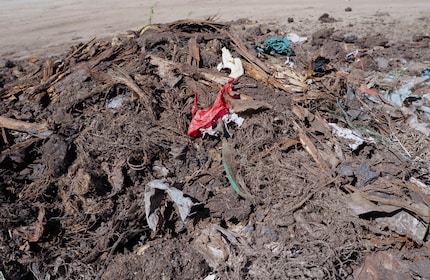
Guide
No garden or balcony? No problem! How to grow herbs indoors
by Darina Schweizer

Bottle caps, glass, plastic film: there’s always a chance you’ll come across unpleasant finds in potting soil. Find out how this happens here from four manufacturers, what you can do and which soil is (almost) plastic-free.
Organic herb and sowing soil without peat – «sounds promising», I thought to myself when I planted my indoor herb garden recently.
But when I opened the bag, I was greeted with thick clumps instead of fine-grained soil. It was only when I turned them over that I realised they were pieces of wood and plastic. I tried to break them up. No use. So I started fishing them out – in the firm belief that there couldn’t be that many. But my eyes widened with each additional chunk that gradually filled the sieve. «You’ve got to be kidding me!» I thought to myself.
No, it’s true. I’m not the only one to find pieces like this either. On Migipedia, Migros’ customer review platform, for example, «Klinker» comments on «too many large parts». «DimeVengeance», «callmeloco», «chregibe» and «Cludi80» also report «inorganic waste», «huge pieces of plastic» and even «half a Lego brick» in the plant soil in their comments on Galaxus.


But not only Migros products are affected. Garden soil from various wholesalers contains plastic waste. K-Tipp recently reported on this.
Why is this?
Peat-free potting soil – a fundamentally environmentally friendly product – contains green waste. This comes from gardens, parks and embankments, among other places. The problem is that it often contains foreign substances. This is because people often carelessly leave their flowers in plastic bags and pots when disposing of them. Or because they chuck their food wrappers on the floor while walking through the park.

Plastic parts are shredded together with the green waste, composted and end up in the processing plant. The materials are then separated from each other in several sieving steps. But that’s where it stops. Alexandra Heckmann, Lead CFM Houseplants and Wildlife at Do it + Garden Migros, explains: «Material with a diameter of 20 to 28 millimetres can pass through our sieves – plus those with even slightly longer edges. This is intended for wood chippings because we want them in our soil. But unfortunately, we can’t prevent plastic particles getting through from time to time.»
Andrea Neuenschwander, Head of Marketing at Hauert HBG Dünger AG, shares a similar observation: «Soil isn’t homogeneous in itself. Although we do the best we can, we can’t completely filter out plastic particles.» Ricoter also emphasises that everything is done in composting plants to filter out foreign matter. «The smaller the pieces are, the more difficult it becomes,» says Beat Sutter, Managing Director of Ricoter Erdaufbereitung AG.
Regine Hofmann, Marketing Manager at COMPO Jardin AG, which distributes COMPO SANA soils, echoes a similar view. She regrets that «despite extensive quality assurance and cleaning measures», they cannot rule out the possibility of «occasional contamination» by foreign substances.
Nevertheless, the major distributors comply with Swiss thresholds in accordance with the Chemical Risk Reduction Ordinance ORRChem. The guidelines for RAL compost specify a maximum amount of foreign matter of 15 square centimetres per litre in the total area. «We average less than 7 square centimetres», says Alexandra Heckmann from Do it + Garden Migros.
Then she mentions something surprising. Foreign substances, as annoying as they may be, also improve the soil in some cases. Pieces of wood, for example, prevent soil from compacting, says Alexandra Heckmann. She also emphasises that compost is a 100 per cent recycled product. Hardly any other consumer good has such a high recycling rate. «The countless benefits of this circular economy can more than compensate for the disadvantage of foreign materials,» says the specialist.
Well, the foreign substances are still annoying for hobby gardeners like me. After all, I’m paying for something that I don’t want in my soil. Even though COMPO SANA states that «contamination with small pieces of plastic has in principle no effect on plants», I wonder whether the same applies to me as a human being. For example, when I eat herbs that have grown in contaminated soil.
So what can be done? Here are two suggestions:
Compost doesn’t necessarily have to be made from green waste. Bark compost is also suitable. Hauert, for example, uses this and fully avoids green compost. Ricoter also primarily uses bark compost in their soil: «It’s practically free of foreign matter,» says Andrea Neuenschwander. Migros and COMPO SANA use bark compost in addition to green compost and other components.
We’re the biggest influence on a plastic-free earth. And we do this by refraining from carelessly disposing of plastics in our green waste or in nature. At the end of the day, we benefit from this ourselves. True to the saying: you’ll reap what you sow.
If you want to plant herbs with as few foreign substances as possible, manufacturers recommend the following products:
By the way: My herb and sowing soil story isn’t over just yet. Follow me to find out what other problem I had to deal with. In the meantime, feel free to let me know in the comments what experiences you’ve had with plastic in potting soil
Header image: Darina Schweizer
I love anything with four legs or roots - especially my shelter cats Jasper and Joy and my collection of succulents. My favourite things to do are stalking around with police dogs and cat coiffeurs on reportages or letting sensitive stories flourish in garden brockis and Japanese gardens.
Interesting facts about products, behind-the-scenes looks at manufacturers and deep-dives on interesting people.
Show all